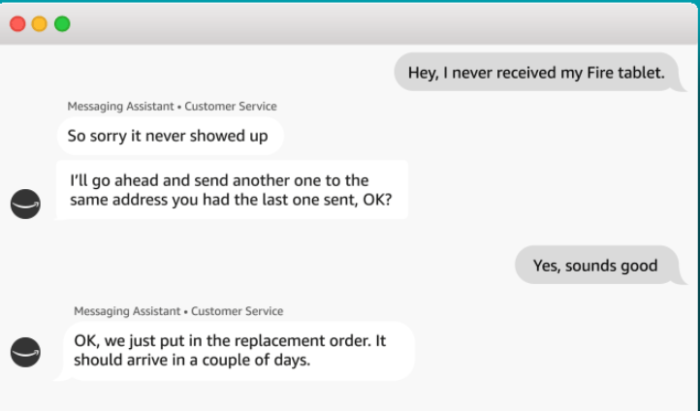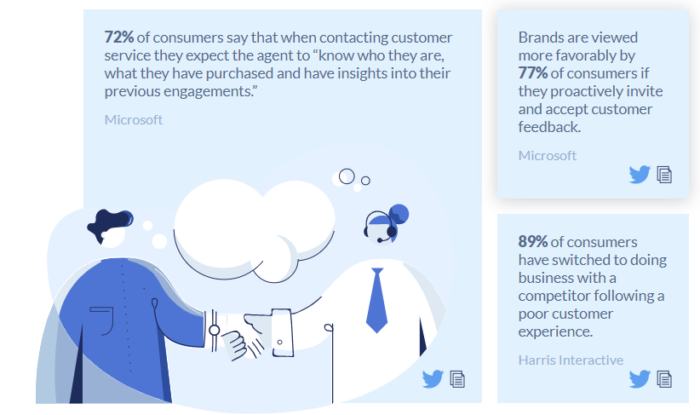
Customer support and customer success can be confusing for both beginners and experts alike.
Both customer support and customer success teams are important for your brand’s ongoing growth and success, and the roles share similar skill sets.
Yet, they are two very different things.
It’s time to clear up the confusion around customer support and customer success for good. In this article, we’ll cover:
- What customer success is and why it’s important.
- What customer support is and why it’s important.
- The key differences between the two terms.
What Is Customer Support?
Customer support is when you help a customer overcome a specific problem. Customer support teams have one-on-one conversations with customers and work closely with product design and engineering teams to fix issues.
For example, customers might reach out through phone, chat, or email to get help with an issue.

Customer support is reactive in that sense. You only provide support when a customer comes to you with a problem. You fix it and move on to the next issue.
Why Is Customer Support Important?
If customers can’t find a solution to their problems, they’ll find a new product or service provider. It’s as simple as that. That’s why customer support is considered a core business function. It doesn’t matter who you are or what you sell; someone at your company should be responsible for customer support.
What Is Customer Success?
Customer success is a proactive approach to solving your customers’ long-term needs. Most brands will use customer success strategies to build long-term relationships with brands, help customers get the most from your product, and help them use your product to meet their goals.
In other words, it’s all about helping them succeed.
Why Is Customer Success Important?
When you invest successfully in customer success, you make your product or tool invaluable to your customer. If you can help them achieve their goals successfully, why would they ever stop paying the monthly subscription?
Customer success can also reduce your business’s customer support needs. Issues will always arise, but they’ll be far less common when users understand how to use your tool or product properly.
No wonder that 72 percent of businesses name improving the customer experience as their top priority.
Customer Success Is Not the Same As Customer Satisfaction
Your customers may be satisfied with your product, but that’s not the same as them succeeding with it.
Read that again because it’s crucial you understand the difference. Customer satisfaction is momentary. Customer success is for the long term. It’s why customer success is proactive in its approach.
6 Key Differences Between Customer Success and Customer Support
Even from the short introduction to customer success and customer support I gave above, it should be obvious that there are some very big differences between the two business functions. Here’s what you need to know about both when it comes to your approach, focus, metrics, ROI, employee skills, and business functions.
1. Approach
How your business approaches customer support versus customer success should be very different. Here are the two approaches I recommend.
Customer Support
As I’ve said already, customer support is reactive. You help customers when they reach out, but you don’t reach out to them. That’s not to say being reactive is a bad thing, however. It’s still essential because 89 percent of consumers will switch to a competitor following a poor experience.

Customer support is also transactional in approach. It’s a service you provide to customers, just like you initially offered them with a product. That means there are defined entry and exit points. The transaction starts when a customer raises a support ticket and ends when the issue has been solved. The relationship ends at that point and doesn’t go any further.
Customer Success
Customer success, on the other hand, is proactive. Your team takes a customer-first approach and actively helps them to achieve their goals without waiting for them to ask.
It means your team aims to help all customers, not just the ones that pipe up with a problem. This is incredibly important as research shows 26 customers remain silent for every single customer that complains.
It’s also a relationship-based approach. The relationship starts as soon as the user becomes a customer, but there’s no defined endpoint. It’s an ongoing process where your company tries to grow and strengthen the relationship as much as possible.
2. Focus
Customer success and customer support don’t take the same approach, nor do they share the same goals or focus. One is very much focused on the short term. The other takes a more longer-term view of the customer.
Customer Support
The focus of customer support is on the short-term satisfaction of your customers. Dissatisfaction levels shoot through the roof when your customer encounters a problem.
Customer support is all about removing the problem and improving those satisfaction levels as quickly as possible.
Customer Success
Customer success, on the other hand, is focused on the long-term satisfaction of your customers. Rather than solve what’s immediately pressing, customer success teams look to the future and make sure customers have all the tools they need to succeed going forward.
While customer support is about keeping a customer in the heat of the moment, customer success is about creating customers for life.
3. Business Function
Customer support and customer success play distinct roles in the function of your business. While one is considered an essential feature, the other is typically a value-added function. Find out which is which below.
Customer Support
Customer support is a fundamental business function that all businesses will have in one form or another. It may be a dedicated team of a dozen employees or a founder answering emails in the evening. Either way, they play an integral role in running the business.
Customer Success
Customer success efforts are usually considered an added value, rather than an essential business function. However, that doesn’t make them any less valuable, but it shouldn’t be considered a necessity for businesses that are just getting off the ground.
If that’s your situation, you are much better off building a customer support team first, and then building a customer success team in the future.
4. Metrics
Customer support and customer success are so different in their approach and focus that they need to have very different metrics to measuring performance. Here are the metrics you need to track for each role.
Customer Support
As a transactional service, customer support metrics are focused on the speed and effectiveness with which customer support reps can service requests. Typical KPIs include:
- time to respond
- percentage of requests answered successfully
- net promoter score
Customer support metrics measure what happens in the moment, not the past or future. Pay particular attention to net promoter and other customer satisfaction scores. Customers share to 15 people, on average, when they have a poor customer experience.
Customer Success
Customer success metrics can be harder to define and calculate because they tend to be long-term metrics. They can include:
- better retention rates
- higher customer lifetime value
- more repeat purchases
- customer satisfaction scores
Customer success metrics measure growth and improvement. The longer you can track the impact of your customer success efforts, the more accurate your metrics will be. Don’t neglect more concrete metrics like repeat purchases, however.
Businesses have a 60 to 70 percent chance of selling to existing customers, but just a 5 to 20 percent chance of selling to new prospects.
5. ROI
It’s important to understand how successful your customer support and customer success functions are. That’s easier said than done, however. Here’s what you need to know about measuring the effectiveness of each team.
Customer Support
The ROI of customer support is well understood by most business executives and reasonably easy to calculate. It can be measured by a number of metrics, including customer satisfaction ratings, retention rates, and referrals.
You may not even be concerned about the ROI of customer support. This is because it’s a core business function and can be considered a necessary cost.
Customer Success
Customer success can be much harder to measure. Some methods to measure customer success ROI include product adoption rates, average daily users, and referrals. It’s very important to measure it, though. As an added business function, it’s important to track whether you’re getting the benefits that are greater or equal to the investment.
Thankfully, the ROI of customer success will typically be much larger than customer support. Research by Fred Reichheld, the inventor of the net promoter score, found that a 5-percent increase in customer retention can lead to a 25 percent increase in profits.
That’s because the benefits of customer success compound over time. The longer your customers use your products, the more income is generated. Cross-sells, upsells, and referrals also add up. By helping one customer to succeed in the long term, your customer success reps could end up winning thousands of dollars in new and repeat business.
6. Employee Skills
Customer support and customer success roles may look similar on the face of it, but don’t expect a customer support rep to work in customer success or vice versa. Each role comes with its own unique set of skills.
Customer Support
Customer support staff care deeply about the product and their customers. They understand the intricacies of the product, how it works, and the typical issues customers run into.
Because they occupy a service role, great interpersonal skills are essential. They need to be empathetic to the customer’s situation and care about finding a solution. They also need to know about their customers. Almost three-quarters of customers expect customer service agents to know who they are.
They also need to work well with other members of your team, specifically the product development team. They’ll be responsible for highlighting frequent issues and finding quick fixes. This is important because over half of global consumers believe companies should take action on feedback provided by customers.
Customer Success
Customer success teams are more focused on the customer rather than the product. They’ll still need to know your product inside out, of course, but they need to be able to build relationships rather than solve problems.
Specifically, your team will need to identify what success looks like to customers and develop a plan to help them achieve that. Marketing skills, as well as interpersonal skills, will be important as a result.
So, too, will be analytical skills. More often than not, the secrets to achieving customer success can be found by delving into your products’ analytics and understanding where a large number of users go wrong.
Conclusion
Customer support is all about providing an essential, reactive service to your product users. Customer success is a powerful and proactive way to improve customer loyalty, boost retentions, and increase referrals. While effective, it’s not as essential as customer support, however.
Customer support and customer success may be different, but they are complementary. They are each responsible for different parts of the customer journey, and together they cover it all.
Now you understand the difference between both customer service functions, you can begin to implement each of them better within your business.
Which customer service functionality do you implement best? Let me know if you’re going to focus on improving customer support or customer success in the comments.
The post The Key Differences Between Customer Support and Customer Success appeared first on Neil Patel.
No comments:
Post a Comment